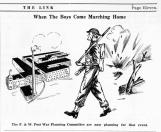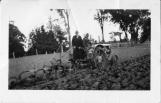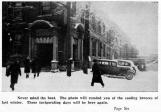1
The Frost & Wood Company changed greatly in the post years. Harry Cockshutt had died unexpectedly in November 1944, and W. Ashton Cockshutt was transferred to Brantford to work as the General Manager of the Brantford Coach and Body Company in 1947. John Stratford would take over W. Ashton Cockshutt's position and then Ed Ryan in 1949.2
Harry Cockshutt Passes Away25 November 1944
Smiths Falls, Ontario, Canada
 Credits:
Credits:Heritage House Museum
3
When the war ended, many women found themselves without jobs, but aware they were just filling in for the time being.By 1949, the Frost & Wood Company was valued at $7,500,000 - an increase of four times of its assessment in 1939. In 1949, the plant also employed 840 workers and paid out $1,921,500 in staff wages.
4
When the Boys Come Marching Home23 September 1943
Smiths Falls, Ontario, Canada
 Credits:
Credits:Heritage House Museum
5
Post war, the Canadian Army was still using Frost & Wood hand grenades.7
When the war ended, much of Europe was in shambles and many thought farm machinery would be in high demand. Cockshutt created a Post War Production Programme to plan for the company's future and the anticipated increase in production.During the war, companies were prohibited from designing new equipment, and were told to focus on producing machines already designed and ready for production. Post war, Cockshutt began looking into designing new machinery, and encouraged employees at Frost & Wood to take part.
9
Frost & Wood began producing new lines of equipment to keep up with the new mechanized age that was post-war Canada. The company began to focus on bigger machines and dropped smaller ones like lawn mowers.Frost & Wood also had an Experimental Department. Here Engineers would test new farm machinery designs for post-war production. To make sure the equipment worked, Frost & Wood would enlist local farmers to test out the new machinery.
The company did just this when testing out their new grain binders. The farmers would have to pay for the gas, but they generally saw it as a good deal because it meant they could cut their grain using a brand new binder.
10
A Cockshutt Tractor and Binder17 June 1939
Smiths Falls, Ontario, Canada
 Credits:
Credits:Heritage House Museum
11
In 1948, Cockshutt bought the North End Plant from the Town of Smiths Falls and converted the building into the company's Eastern Sales Branch. The building included offices, a showroom, machinery storage and a shipping department.The name Frost & Wood, however, began to be left off of Cockshutt Plow Company literature.
12
Cockshutt Tractor Demonstration8 June 1938
Arnprior, Ontario, Canada
 Credits:
Credits:Heritage House Museum
13
By the early 1950s, production had been going so well for the company, management at Frost & Wood were planning to expand the plant and a new warehouse had already been built. Still, constant rumours about the plant closing circulated around the factory and some employees even starting calling the company "Fret & Worry" instead of Frost & Wood.14
Frost & Wood Head Office in Wintertime25 August 1944
Smiths Falls, Ontario, Canada
 Credits:
Credits:Heritage House Museum

